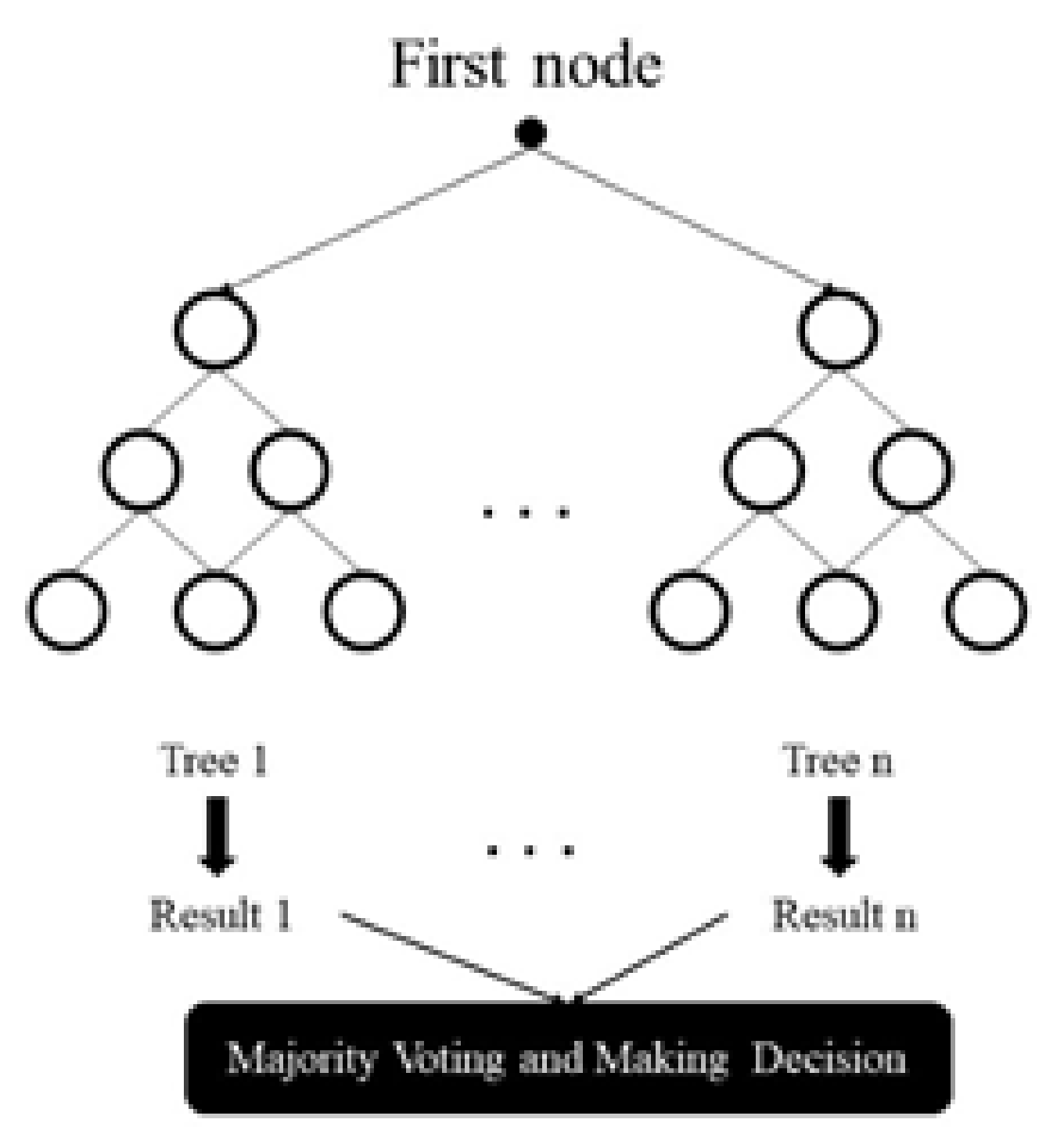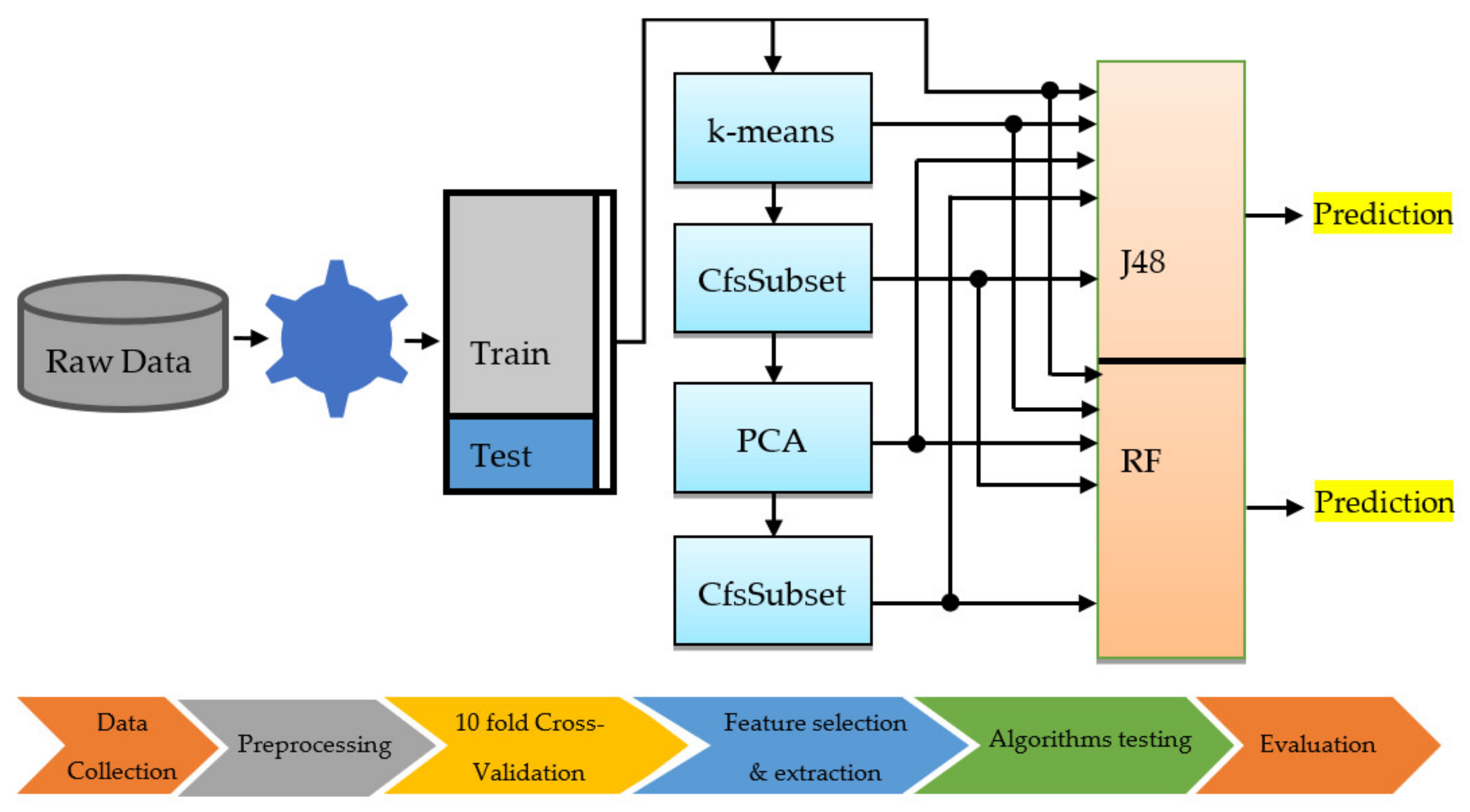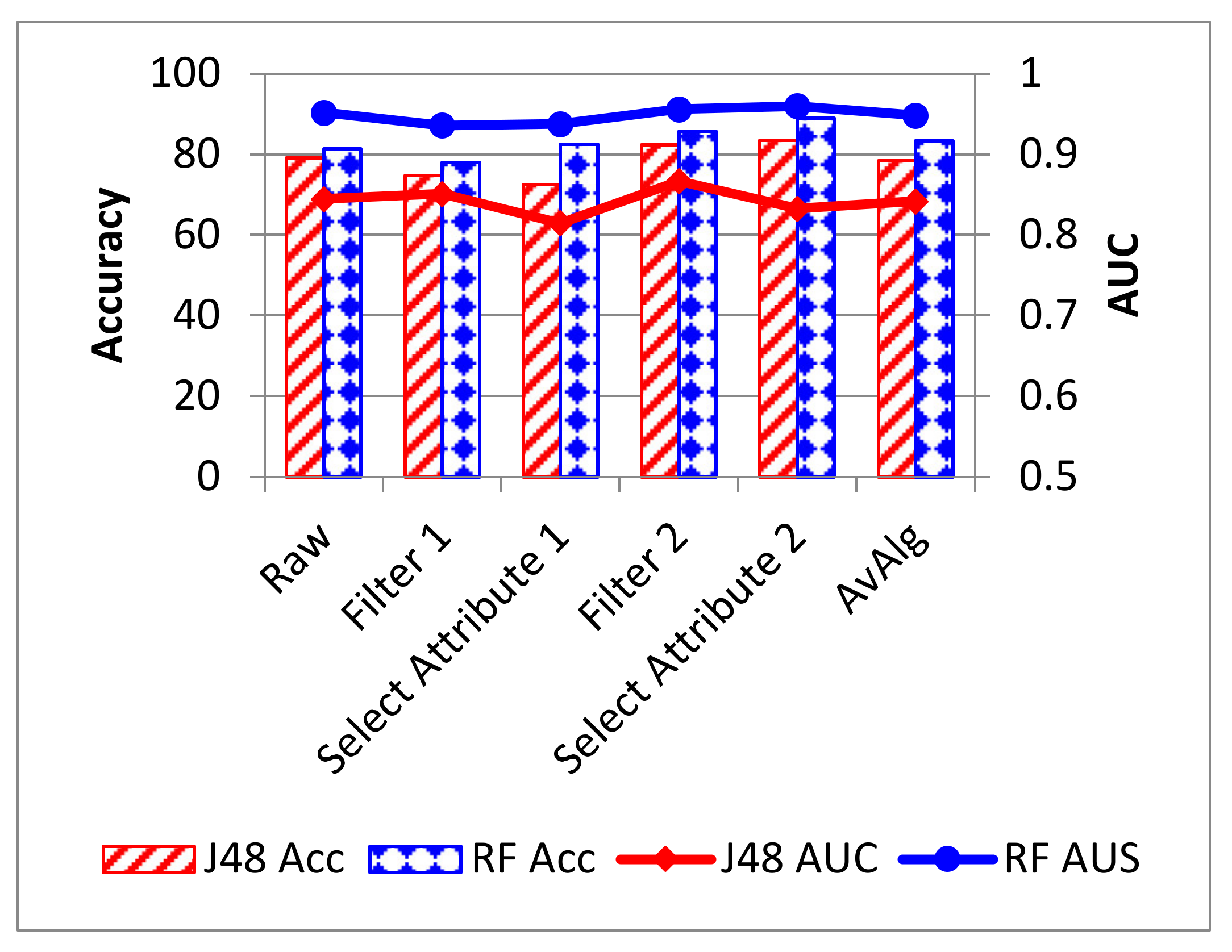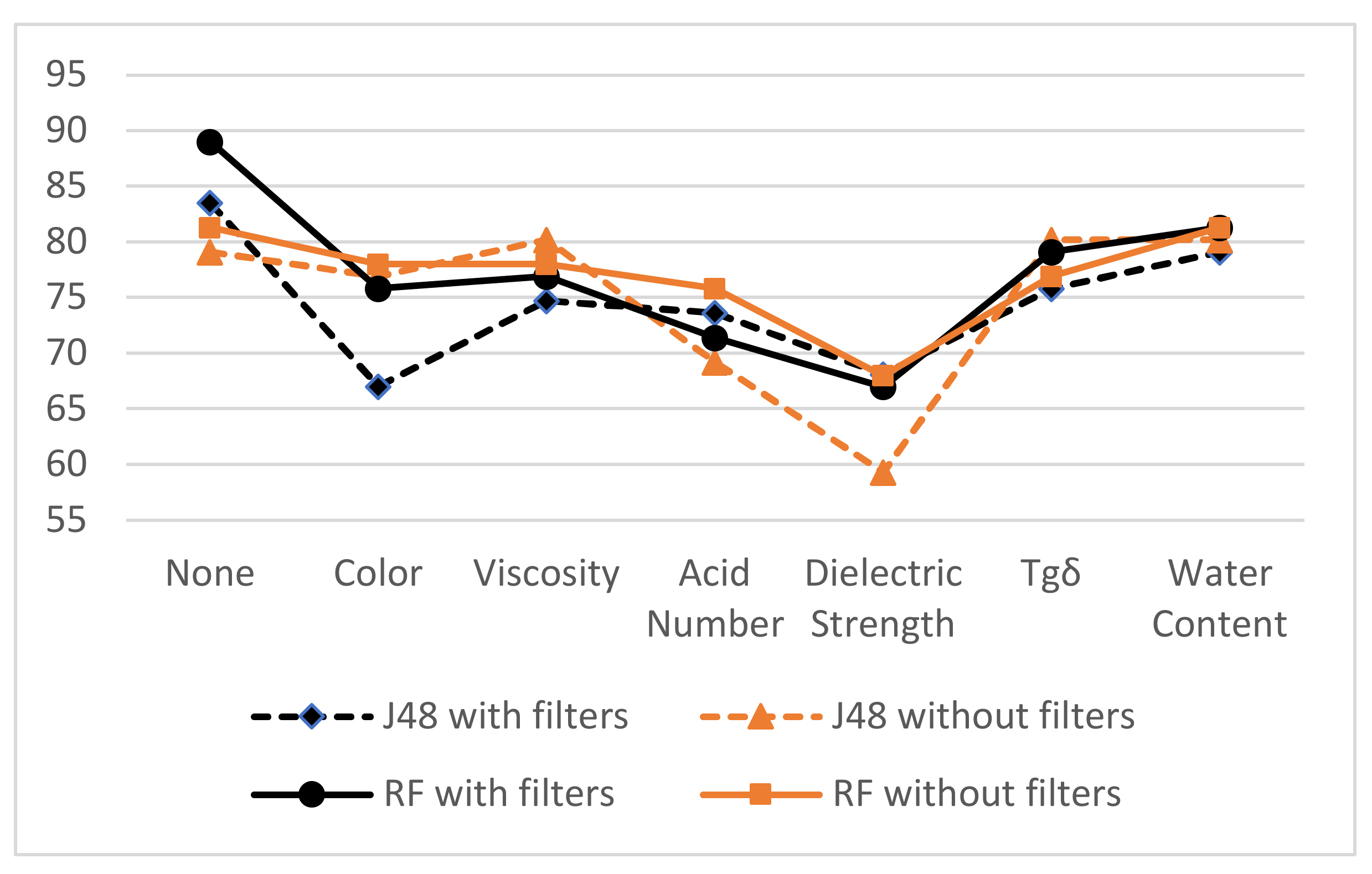Transformer Oil Quality Assessment Using Random Forest with Feature Engineering
Abstract
1. Introduction
- The proposed classifiers (J48 and random forest) have not been used before for assessing the quality of transformer oils. The reason why these algorithms are used is because they have had numerous successful applications in many fields, such as image processing, biomedicine, and economic pattern classification, due to their antinoising advantages and better model generalization abilities [14]. In addition, due to lack of data, algorithms such as J48 decision tree and random forest are more appropriate for building the prediction model with a relatively small amount of data.
- Before feeding the algorithms, the data used were preprocessed by passing through different filters that fall within the so-called features engineering. The goal of this is to change the shape of the data so that the prediction algorithms can acquire additional information that helps improve classification capabilities.
2. Oil Quality Testing
3. Materials and Methods
3.1. Description of Data
- Group I—oils that are in satisfactory condition for continued use.
- Group II—oils that only require reconditioning (by settling, filtering, centrifuging, and vacuum drying or degassing [28]) for further service.
- Group III—oils in poor condition. Such oil should be reclaimed (restored to usefulness by the removal of contaminants and products of degradation such as polar, acidic, or colloidal materials from used electrical insulating liquids by chemical or adsorbent means [28]) or disposed of depending upon economic considerations.
- Group IV—oils in such a poor condition that it is technically advisable to dispose of them.
3.2. Algorithms
3.2.1. J48 Decision Tree
3.2.2. Random Forest
3.3. Feature Extraction
3.3.1. PCA
3.3.2. K-Means Algorithm
3.4. Feature Selection
3.5. Validation of Classifiers
3.6. Evaluation Metrics
4. Experiments and Discussion of Results
5. Conclusions
- -
- By exploring the used datasets, the change in the quality of oil is reflected in the physicochemical parameters, except the viscosity, which is not affected. Oil parameters influence each other, and acidity and water content are the most influential parameters. Both observations are consistent with the finding of some studies [4,48,49], which confirms that our data are actual and suitable for machine learning.
- -
- Random forest is superior to the J48 algorithm for classification with an 89% accuracy and 0.96 AUC. In the J48 algorithm, the accuracy and AUC do not exceed 83.3% and 0.83, respectively.
- -
- The performance of the used classifier is not the only factor affecting the result quality; the data preprocessing method also influences this quality. Two strategies of data preprocessing are applied in the present paper through four steps, and a distinct improvement was achieved. In the first step, feature extraction was performed, where the original features were transformed into new features by using the simple k-means technique. Subsequently, the new features were filtered using the “CfsSubsetEval” algorithm to adopt only the relevant features in the second step. The same steps were then repeated, but for feature extraction PCA was performed instead of simple k-means.
- -
- Random forest exhibits a better performance than J48 irrespective of the data size, and it does not require large amounts of data to achieve relatively better results.
Author Contributions
Funding
Institutional Review Board Statement
Informed Consent Statement
Data Availability Statement
Acknowledgments
Conflicts of Interest
References
- Krontiris, A. Fuzzy Systems for Condition Assessment of Equipment in Electric Power Systems. Ph.D. Thesis, Darmstadt University of Technology, Darmstadt, Germany, March 2012. [Google Scholar]
- Boudraa, S.; Mokhnache, L.; Fofana, I. Artificial neural networks for predicting the gassing tendency under electrical discharge in insulating oil for extended time. J. Electr. Eng. 2014, 14, 45–52. [Google Scholar]
- Meshkatoddini, M.R. Aging Study and Lifetime Estimation of Transformer Mineral Oil. Am. J. Eng. Appl. Sci. 2008, 1, 384–388. [Google Scholar] [CrossRef]
- Rao, U.M.; Fofana, I.; Betie, A.; Senoussaoui, M.L.; Brahami, M.; Briosso, E. Condition monitoring of in-service oil-filled transformers: Case studies and experience. IEEE Electr. Insul. Mag. 2019, 35, 33–42. [Google Scholar] [CrossRef]
- Pahlavanpour, B.; Roberts, I.A. Transformer oil condition monitoring. In IEE Colloquium on Transformer Life Management (Ref. No. 1998/510); The Institution of Engineering and Technology: London, UK, 1998. [Google Scholar]
- Chakravorti, S.; Dey, D.; Chatterjee, B. Recent Trends in the Condition Monitoring of Transformers: Theory, Implementation and Analysis; Springer-Verlag: London, UK, 2013. [Google Scholar]
- N’cho, J.S.; Fofana, I.; Hadjadj, Y.; Beroual, A. Review of Physicochemical-Based Diagnostic Techniques for Assessing Insulation Condition in Aged Transformers. Energies 2016, 9, 367. [Google Scholar] [CrossRef]
- James, R.E.; Su, Q. Condition Assessment of High Voltage Insulation in Power System Equipment, Power and Energy; The Institution of Engineering and Technology: London, UK, 2008. [Google Scholar]
- Ma, H.; Saha, T.K.; Ekanayake, C.; Martin, D. Smart Transformer for Smart Grid—Intelligent Framework and Techniques for Power Transformer Asset Management. IEEE Trans. Smart Grid 2015, 6, 1026–1034. [Google Scholar] [CrossRef]
- Mokhnache, L. Application de RN Dans le Diagnostique et la Prédiction des Isolations HT (Neural Network Application for the Diagnostic and the Prediction of High Voltage Isolation). Ph.D Thesis, Ecole National Polytechnique Alger, Algiers, Algeria, January 2004. [Google Scholar]
- Ma, H.; Saha, T.K.; Ekanayake, C.; Allen, D. Modern Machine Learning Techniques for Power Transformer Condition Assessment. CIGRE Session 44; CIGRE: Paris, France, 2012. [Google Scholar]
- Prasojo, R.A.; Suwarno, S. Power Transformer Paper Insulation Assessment based on Oil Measurement Data using SVM-Classifier. Int. J. Electr. Eng. Inform. 2018, 10, 661–673. [Google Scholar] [CrossRef]
- Ma, H.; Saha, T.K.; Ekanayake, C. Machine Learning Techniques for Power Transformer Insulation Diagnosis. In Proceedings of the AUPEC 2011, Brisbane, Australia, 1–6 September 2011. [Google Scholar]
- Alqudsi, A.; El-Hag, A. Application of Machine Learning in Transformer Health Index Prediction. Energies 2019, 12, 2694. [Google Scholar] [CrossRef]
- Chen, X.; Cui, H.; Luo, L. Fault Diagnosis of Transformer Based on Random Forest. In Proceedings of the 2011 Fourth International Conference on Intelligent Computation Technology and Automation, Shenzhen, China, 28–29 March 2011; pp. 132–134. [Google Scholar]
- Mokhnache, L.; Boubakeur, A. Comparison of different back-propagation algorithms used in the diagnosis of transformer oil. Annu. Rep. Conf. Electr. Insul. Dielectr. Phenom. 2003, 244–247. [Google Scholar] [CrossRef]
- Mokhnache, L.; Boubakeur, A.; Nait Said, N. Application of Neural Networks Paradigms in the Diagnosis and Thermal Ageing Prediction of Transformer Oil. In Proceeding of 14th International Conference on Dielectric Liquids (ICDL 2002), Graz, Austria, 7–12 July 2002. [Google Scholar]
- Mokhnache, L.; Kada, C.; Boubakeur, A.; Nait Said, N. Fuzzy Logic System for Oil Insulated Transformer Diagnosis. In Proceedings of the 5th International Conference on Quality, Reliability and Maintenance, Oxford, UK, 1–2 April 2004. [Google Scholar]
- Siddique, M.A.A.; Mehfuz, S. Artificial neural networks based incipient fault diagnosis for power transformers. In Proceedings of the 2015 Annual IEEE India Conference (INDICON), New Delhi, India, 17–20 December 2015; pp. 1–6. [Google Scholar]
- Thang, K.; Aggarwal, R.; McGrail, A.; Esp, D. Analysis of power transformer dissolved gas data using the self-organizing map. IEEE Trans. Power Deliv. 2003, 18, 1241–1248. [Google Scholar] [CrossRef]
- Senoussaoui, M.E.; Brahami, M.; Fofana, I. Combining and comparing various machine-learning algorithms to improve dissolved gas analysis interpretation. IET Gener. Transm. Distrib. 2018, 12, 3673–3679. [Google Scholar] [CrossRef]
- Piotr, M.; Yann, L. Statistical machine learning and dissolve gas analysis: A Review. IEEE Trans. Power Deliv. 2012, 27, 1791–1799. [Google Scholar]
- Wang, M.; Vandermaar, A.J.; Srivastava, K.D. Review of condition assessment of power transformers in service. IEEE Electr. Insul. Mag. 2002, 18, 12–25. [Google Scholar] [CrossRef]
- IEEE C57.637-2015-IEEE Guide for the Reclamation of Mineral Insulating Oil and Criteria for Its Use; IEEE Std C57.637-2015 (Revision of IEEE Std 637-1985); IEEE SA standard association: New York, NY, USA, 2015; pp. 1–38.
- Hochard, B. Le Transformateur de Puissance; Technique et documentation (Lavoisier): Paris, France, 1988. [Google Scholar]
- Hadjadj, Y. Exploration de Techniques Physicochimiques et Conception d’un Capteur en Ligne Pour le Diagnostic des Transformateurs de Puissance. Ph.D Thesis, University of Quebec in Chicoutimi, Chicoutimi, QC, Canada, 2015. [Google Scholar]
- Myers, D.; Kelly, J.J.; Parrish, R.H. Transformer Maintenance Guide; Transformer Maintenance Institute: Akron, OH, USA, 1981. [Google Scholar]
- N’cho, J.S.; Fofana, I.; Beroual, A.; Aka-Ngnui, T.; Sabau, J. Aged Oils Reclamation: Facts and Arguments based on Laboratory Studies. IEEE Trans. Dielectr. Electr. Insul. (TDEI) 2012, 19, 1583–1592. [Google Scholar] [CrossRef]
- Abdi, S.; Boubakeur, A.; Haddad, A.; Harid, N. Influence of Artificial Thermal Aging on Transformer Oil Properties. Electr. Power Components Syst. 2011, 39, 1701–1711. [Google Scholar] [CrossRef]
- Saha, T.; Darveniza, M.; Hill, D.; Le, T. Electrical and chemical diagnostics of transformers insulation. B. Accelerated aged insulation samples. IEEE Trans. Power Deliv. 1997, 12, 1555–1561. [Google Scholar] [CrossRef]
- Christopher, A.B.A.; Balamurugan, S.A.A. Prediction of warning level in aircraft accidents using data mining techniques. Aeronaut. J. 2014, 118, 935–952. [Google Scholar] [CrossRef]
- Ashkezari, A.D.; Ma, H.; Saha, T.K.; Ekanayake, C. Application of fuzzy support vector machine for determining the health index of the insulation system of in-service power transformers. IEEE Trans. Dielectr. Electr. Insul. 2013, 20, 965–973. [Google Scholar] [CrossRef]
- Quinlan, J.R. C4.5: Programs for Machine Learning; Morgan Kaufmann: San Mateo, CA, USA, 1993. [Google Scholar]
- Bhargava, N.; Sharma, S.; Purohit, R.; Rathore, P.S. Prediction of recurrence cancer using J48 algorithm. In Proceedings of the 2017 2nd International Conference on Communication and Electronics Systems (ICCES), Coimbatore, India, 19–20 October 2017; pp. 386–390. [Google Scholar]
- Maulana, M.F.; Defriani, M. Logistic Model Tree and Decision Tree J48 Algorithms for Predicting the Length of Study Period. J. Penel. IImu. Komp. Syst. Embed. Log. 2020, 8, 39–48. [Google Scholar] [CrossRef]
- Biau, G. Analysis of a random forests model. J. Mach. Learn. Res. 2012, 13, 1063–1095. [Google Scholar]
- Nabipour, M.; Nayyeri, P.; Jabani, H.; Mosavi, A.; Salwana, E.; Shahab, S. Deep Learning for Stock Market Prediction. Entropy 2020, 22, 840. [Google Scholar] [CrossRef]
- Breiman, L. Random Forests. Mach. Learn. 2001, 45, 5–32. [Google Scholar] [CrossRef]
- Rokach, L. Ensemble-based classifiers. Artif. Intell. Rev. 2010, 33, 1–39. [Google Scholar] [CrossRef]
- Khalid, S.; Khalil, T.; Nasreen, S. A survey of feature selection and feature extraction techniques in machine learning. In Proceedings of the Science and Information Conference (SAI), London, UK, 27–29 August 2014; pp. 372–378. [Google Scholar]
- Pearson, K. On lines and planes of closest fit to systems of points in space. Lond. Edinb. Dublin Philos. Mag. J. Sci. 1901, 2, 559–572. [Google Scholar] [CrossRef]
- Ghojogh, B.; Samad, M.N.; Mashhadi, S.A.; Kapoor, T.; Ali, W.; Karray, F.; Crowley, M. Feature selection and feature extraction in pattern analysis: A literature review. arXiv 2019, arXiv:1905.02845. [Google Scholar]
- Chang, M.-C.; Bus, P.; Schmitt, S. Feature extraction and k-means clustering approach to explore important features of urban identity. In Proceedings of the 16th IEEE International Conference on Machine Learning and Applications, ICMLA 2017, Cancun, Mexico, 18–21 December 2017; pp. 1139–1144. [Google Scholar]
- Khammas, B.M.; Monemi, A.; Bassi, J.S.; Ismail, I.; Nor, S.M.; Marsono, M.N. Feature selection and machine learning classification for malware detection. J. Teknol. 2015, 77, 234–250. [Google Scholar] [CrossRef]
- Cantürk, İ.; Karabiber, F. A machine learning system for the diagnosis of Parkinson’s disease from speech signals and its application to multiple speech signal types. Arab. J. Sci. Eng. 2016, 41, 5049–5059. [Google Scholar] [CrossRef]
- Witten, I.H.; Frank, E. Data Mining: Practical Machine Learning Tools and Techniques; Morgan Kaufmann: Boston, MA, USA, 2005. [Google Scholar]
- Weiss, S.M.; Battistin, A. Generating Well-Behaved Learning Curves: An Empirical Study. In Proceedings of the International Conference on Data Mining (DMIN), The Steering Committee of The World Congress in Computer Science, Computer Engineering and Applied Computing (WorldComp), Las Vegas, NV, USA, 21–24 July 2014; pp. 1–4. [Google Scholar]
- Hadjadj, Y.; Fofana, I.; Sabau, J.; Briosso, E. Assessing insulating oil degradation by means of turbidity and UV/VIS spectrophotometry measurements. IEEE Trans. Dielectr. Electr. Insul. 2015, 22, 2653–2660. [Google Scholar] [CrossRef]
- Fofana, I.; Bouaicha, A.; Farzaneh, M.; Sabau, J. Ageing Behaviour of Mineral Oil and Ester Liquids: A Comparative Study. In Proceedings of the 2008 Annual Report Conference on Electrical Insulation and Dielectric Phenomena, Quebec, QC, Canada, 26–28 October 2008; pp. 87–90. [Google Scholar] [CrossRef]








| Type of Test | ASTM Method | Significance/Effects |
|---|---|---|
| Dielectric Breakdown | D877, D1816 | Describes the oil’s function as an insulant. This parameter is affected by moisture, particles, cellulose fibers and temperature. |
| Neutralization Number | D644, D974 | Represents a measure of the trace amount of acidic or alkaline contaminants in the insulating liquid. With increasing oxidation level of in-service oil, polar compounds, particularly organic acids form in the oil. |
| Interfacial Tension (IFT) | D971 | Indicates the presence of polar contaminants, acids, solvents, varnish. This is a useful screening method for in-service oils exposed to soaps, acids, varnishes, and solvents. |
| Water Content | D1533 | Increases electric conductivity and dissipation factor and lowers the electric strength. Moisture increase may arrive from excessive paper decomposition. |
| Power Factor | D924 (100, 25 C) | Describes the insulating liquid’s function as a dielectric. This parameter is affected by contaminants (moisture, conductive particles, dissolved metals, peroxides, acids, salts/overheating, etc.) |
| Oxidation Inhibitor (DBPC 1) | D2668, D1473 | Represents a quantitative assessment of the amount of inhibitors by mass in the liquids. With increase in aging, the inhibitors are consumed and need to be replenished when needed. |
| Metals in Oil | The presence of metal contaminants may affect many oil properties. This is generally indicative of pump wear, arcing or sparking with metal. |
| Test Item | Standard | Limit Values |
|---|---|---|
| Color | ASTM D1500 | ≤2 |
| tgδ | IEC 60250, | <0.3 |
| Acidity (mgKOH/g) | IEC 60296 | <0.1 |
| Viscosity (cSt) | NF-T-60 100 | <10.5 |
| Dielectric strength (kV) | IEC 60156 | ≥40 |
| Water content (ppm) | ISO 12-760 | <30 |
| Color | Viscosity | Acid Number | Dielectric Strength | Tgδ | Water Content | |
|---|---|---|---|---|---|---|
| Color | 1 | |||||
| Viscosity | 0.041859 | 1 | ||||
| Acid Number | 0.445081 | 0.103748 | 1 | |||
| Dielectric Strength | −0.13946 | −0.03912 | −0.26409 | 1 | ||
| Tgδ | 0.262958 | 0.111397 | 0.695077 | −0.32828 | 1 | |
| Water Content | 0.133563 | 0.190597 | 0.367912 | −0.55923 | 0.295186 | 1 |
| Test Item | Colour | Viscosity | Acidity | Dielectric Strength | Tgδ | Water Content | Actual Decision | J48 Prediction | RF Prediction | |
|---|---|---|---|---|---|---|---|---|---|---|
| Limit Values | 2 | 10.5 | 0.1 | 40 | 0.3 | 30 | ||||
| Data instances | 1 | 0.7 | 10.23 | 0.012 | 57 | 0.072 | 16 | Keep | Keep | Keep |
| 2 | 2.3 | 10.87 | 0.091 | 22 | 0.019 | 40 | Filter | Filter | Filter | |
| 3 | 4.5 | 11.19 | 0.42 | 30 | 0.55 | 42 | Discard | Discard | Discard | |
| 4 | 2.9 | 10.97 | 0.021 | 65 | 0.018 | 7 | Keep | Keep | Keep | |
| 5 | 3.4 | 11.5 | 0.07 | 57 | 0.105 | 23 | Reclaim | Keep | Reclaim | |
| 6 | 1 | 12.45 | 0.046 | 56 | 0.15 | 31 | Keep | Keep | Keep | |
| 7 | 2 | 10 | 0.106 | 50 | 0.025 | 35 | Filter | Filter | Filter | |
| 8 | 2 | 12.3 | 0.062 | 52 | 0.020 | 32 | Keep | Keep | Keep | |
| 9 | 4 | 12 | 0.08 | 48 | 0.022 | 37 | Reclaim | Reclaim | Reclaim | |
| 10 | 4 | 12 | 0.3 | 30 | 0.6 | 42 | Discard | Discard | Discard |
Publisher’s Note: MDPI stays neutral with regard to jurisdictional claims in published maps and institutional affiliations. |
© 2021 by the authors. Licensee MDPI, Basel, Switzerland. This article is an open access article distributed under the terms and conditions of the Creative Commons Attribution (CC BY) license (http://creativecommons.org/licenses/by/4.0/).
Share and Cite
Senoussaoui, M.E.A.; Brahami, M.; Fofana, I. Transformer Oil Quality Assessment Using Random Forest with Feature Engineering. Energies 2021, 14, 1809. https://doi.org/10.3390/en14071809
Senoussaoui MEA, Brahami M, Fofana I. Transformer Oil Quality Assessment Using Random Forest with Feature Engineering. Energies. 2021; 14(7):1809. https://doi.org/10.3390/en14071809
Chicago/Turabian StyleSenoussaoui, Mohammed El Amine, Mostefa Brahami, and Issouf Fofana. 2021. "Transformer Oil Quality Assessment Using Random Forest with Feature Engineering" Energies 14, no. 7: 1809. https://doi.org/10.3390/en14071809
APA StyleSenoussaoui, M. E. A., Brahami, M., & Fofana, I. (2021). Transformer Oil Quality Assessment Using Random Forest with Feature Engineering. Energies, 14(7), 1809. https://doi.org/10.3390/en14071809







